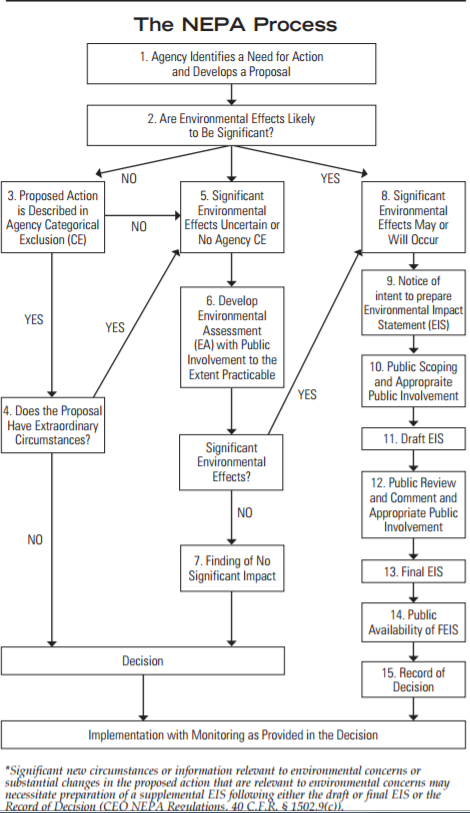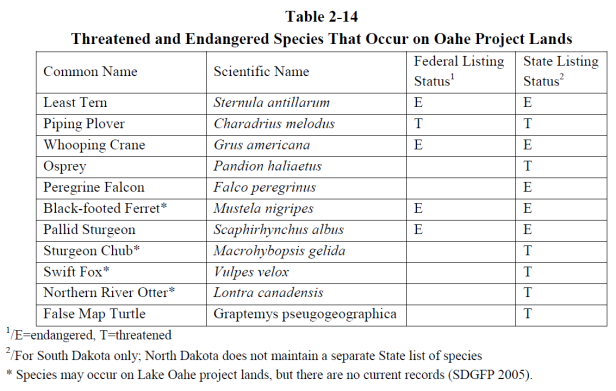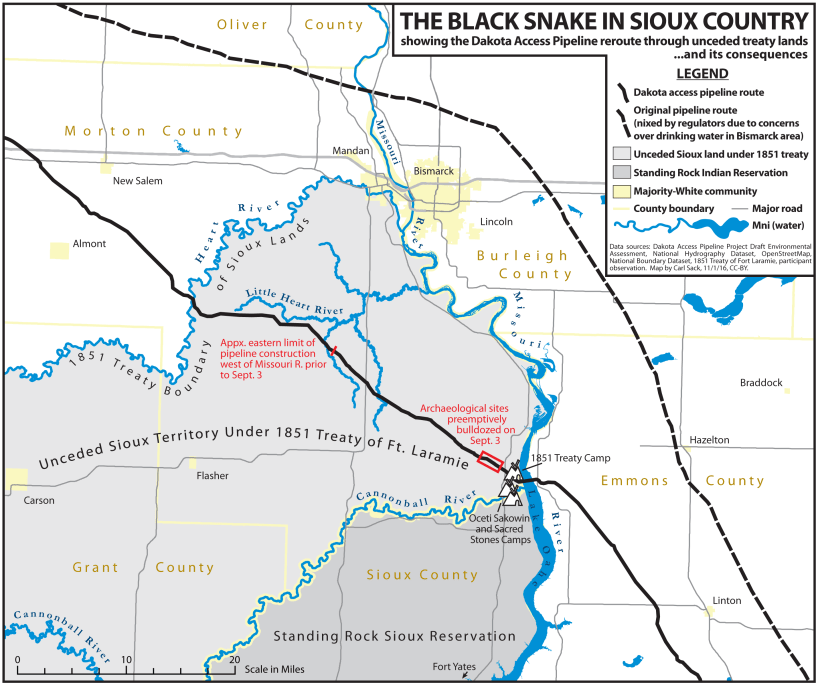As a result of protests against the pipeline’s intended path through an important Sioux watershed, the Department of Defense (Army Corps of Engineers) has initiated the Environmental Impact Statement (EIS) process under the National Environmental Policy Act (NEPA 1970) regarding the proposed Dakota Access Pipe Line’s request for easement across the Missouri River at Lake Oahe. The lake has important downstream uses (AND RIGHTS) for the Sioux Reservation just below the proposed crossing, and the pipeline generates considerable risks to these downstream uses, including fishing and water rights.
EIS’s are tools for measuring tradeoffs between alternative actions that affect the human environment, without quantifying everything in monetary terms. In a case like this, where cultural rights are significant to the values, Benefit-Cost Analysis is not sufficient. But EIS’s are prone to a fair amount of subjectivity, and can be influenced by both agency and public inputs.
The NEPA process has a few important places for public input. This figure from “A Citizen’s Guide to the NEPA: Having Your Voice Heard (BLM, 2007)” illustrates the process.

We are at Steps 9 and 10: the Notice of Intent (NOI) has gone out and the call for comments for the Scoping of the EIS is open until February 20th.
The Army Corps says it is looking specifically for comments on:
“the following three scoping concerns:
(1) Alternative locations for the pipeline crossing the Missouri River;
(2) Potential risks and impacts of an oil spill, and potential impacts to Lake Oahe, the Standing Rock Sioux Tribe’s water intakes, and the Tribe’s water, treaty fishing, and hunting rights; and
(3) Information on the extent and location of the Tribe’s treaty rights in Lake Oahe.”
The new Trump Administration does not wish the EIS to go forward, and has asked in an ‘executive order‘ for the Corps to “withdraw the Notice of Intent to Prepare an Environmental Impact Statement in Connection with Dakota Access, LLC’s Request for an Easement to Cross Lake Oahe, North Dakota, dated January 18, 2017, and published at 82 Fed. Reg. 5543” (which they cannot do – without invoking a whole lot of alternative facts, now that ‘significant effects to the human environment’ are in play, see above figure, but that Bloomberg reports is likely nonetheless).
The pipeline is intended to move oil from the North Dakota to markets to the Southeast. Currently this output is moving primarily by train and truck, but the overall profitability of the oil extraction at current prices by any means has become much less certain than when these projects started. The economics of the region appears a bit confused at the moment, with production up but drilling rigs down. Other recent numbers are less ambiguous and show decline also in permits (this is post-election!) which should be felt in about a year.
While the pipeline is near completion (map of issues here), we must remember, and Energy Transfer Partners certainly knows, that Sunk Costs should not actually be allowed to matter. The original planned path was originally proposed – and rejected due to water quality concerns. Why was this path the original choice? Possibly to avoid the more culturally sensitive, higher value and use Sioux lands and water? This ACE permit is just a much huger case of the rich man who wants to build an oceanfront home but does not have the permits, who discovers that the ex-post fines are much less than permit compliance so he goes ahead and builds, paying the penalty but getting his house. And then, putting the bill on others when a storm or mudslide or other natural disaster destroys that home (avoidance of which having been the purpose of the regulations).
The argument that train and truck are less safe than pipelines may ring true at first, but the truth is murkier – goals matter (see map below for oil spills from pipelines over 30 years). As Forbes points out here (a few years ago now), your preferences for how to move oil depend on your calculus over property destruction, environmental damage, or “normalized amount of oil spilled.” Sometimes pipelines are preferable, sometimes rail and truck are. Thus an alternative in the EIS as “dire” as one that includes failing to complete the pipeline should not even fail to be viable when the true benefits and costs are weighed.
And so – NEPA’s scoping and the way it handles the ‘no action’ alternative will matter to their eventual findings.
Thus it is imperative that we do what we can not only to make sure the EIS goes forward but also that the scoping accounts properly for all the feasible alternatives. You can comment directly, with some help from Standing with Standing Rock, here:
where all you need to do is click on the “START WRITING” link and an email will open up properly addressed and headed so that it is read and counted in the scoping process. Almost 68,000 letters have been sent so far.
What might you say in your letter? Probably two things could help. (1) Reaffirm your strong belief that there will be significant impact to the human environment and that the EIS MUST GO FORWARD IN FULL, perhaps using some of the graphics here showing the frequency and magnitude of pipeline spills over the past 30 years, which are fairly impressive (a sample is below);
https://georgejosephmapping.carto.com/builder/6f9eca1a-b66e-11e6-bc8d-0ef24382571b/embed
And (2), try to stress any concerns you have about violations of laws that will occur if the pipeline access is granted. This is because it will primarily be the other laws, not NEPA, that ACE will pay attention to in avoiding alternative choices once they are preparing the EIS. I am aware of this because the data I used in my dissertation came from over 200 Environmental Assessments and Environmental Impact Statements from the 1970s to the mid 1990s that I gathered from Forest Service offices, NEPA officers, and Government Depository Libraries. One of my main hypotheses concerned the amount of manipulation that occurs in this process in order to achieve the end result desired by the Lead Agency. If you really want, you can read about that here (Kaiser, 2006).
In this case, I do not know what the Army Corps of Engineers’ preferences are, I only know that they will react to specific public input. In particular, they will react most strongly to requirements from other laws with greater teeth. I am not a lawyer, but some of the laws most relevant here will likely be:
The Mineral Leasing Act (which gives the ACE jurisdiction here in the first place, since it manages the reservoir)
The Clean Water Act (1972) and the Oil Pollution Act (1990), which would pertain to potential obvious damages from the pipeline.
The Endangered Species Act (1973) , because as the table below taken from the Army’s Memorandum on the Dam at Lake Oahe shows, the Corps is aware of their presence in the area:

Any and all laws pertaining to Indian tribe rights, treaties and their violations, and the Sioux’s standing in particular.
So, when you are writing your comments to the ACE, use these and any other insights you have to “tribal treaty rights, natural resources, cultural and sacred places, socio-economical concerns, environmental justice, and the health and wellbeing of those downstream who rely on our drinking water. (Stand with Standing Rock).
I think it may also be worth it to emphasize that the EIS alternatives be as specific to Lake Oahe and the Standing Rock Sioux Rights as possible, while encompassing the full range of concerns above. EIS alternatives should indicate the goals that the alternative will meet (e.g. timber supply, water quality). These goals should comprehensively include the topics above and should not obfuscate the tradeoffs by treating different environmental and/or cultural aspects in different alternatives – all alternatives should address all relevant impacts in comparable fashion.
In the course of EIS development from the 1970s to the 1990s, Forest Service EISs went from rather straightforward accounts of clear alternatives for timber sale actions and their expected impacts on local water, wildlife, recreation and so on to voluminous tomes with fancy models and references to conditions that didn’t really match the question at hand – often obscuring the real expectations and increasing the challenge of reviewing the findings. This is in the best interest of the agency as it appears exhaustive and thorough and deters comments, while it is often less meaningful than more specific approaches. It should be discouraged.
When it comes time for the next round of public comment, I’ll let you know.
Cover map image credit: – http://www.huffingtonpost.com/entry/a-nodapl-map_us_581a0623e4b014443087af35,https://northlandia.wordpress.com/2016/11/01/a-nodapl-map/

